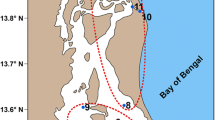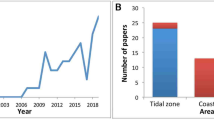Abstract
We assessed the potential of marine ciliate community as an indicator to coastal water quality using water samples collected from four stations in the Yellow Sea in the summer 2000. The four stations were characterized by different levels of pollution. The ciliate communities consisted primarily of tintinnids and aloricate ciliates that were <30 μm. A total of 78 species were classified: 55 species at Station 2, 51 species each at Stations 1 and 4, and 47 species at Station 3. The mean number of species at each site was 29.2±2.0 (Station 1), 28.5±2.9 (Station 2), 27.8±1.7 (Station 3), and 24.5±2.3 (Station 4). The abundance was highly variable: 19 331±11 187 ind./L at Station 1, 7 960±5 639 ind./L at Station 2, 29 015±12 999 ind./L at Station 3, and 8 190±4 658 ind./L at Station 4. Our results suggest that neither the simple chemical analysis (e.g. chemical oxygen demand, dissolved inorganic nitrogen, and phosphate) nor the eutrophication/pollution index adequately described the water quality at the four stations. The same was true of the number of species and their abundance, both of which had no correlation with the chemical indices. In contrast, Margalef’s diversity index values (3.12 at Station 2, 2.89 at Station 1, and 2.64 at Stations 3 and 4) generally discriminated the water quality status of the four stations. The difference in water quality among the stations was strongly supported by the pattern of species richness (i.e. the total number of species) of ciliates at each station. Our evaluation was consistent with the results of long-term water quality monitoring at the four stations. With increasing eutrophication, we observed also a compositional and functional shift in the ciliate assemblages from algivorous oligotrich/choreotrich to nonselective-omnivorous gymnostomatids to bacterivorous-detrivorous scuticociliatids. Thus, ciliates may be used to indicate the coastal water quality status of a given site.
Similar content being viewed by others
References
Bark A W, Goodfellow J G. 1985. Studies on ciliated protozoa in eutrophic lakes: 2. Field and laboratory studies on the effects of oxygen and other chemical gradients on ciliate distribution. Hydrobiologia, 124: 177–188.
Beaver J R, Crisman T L. 1982. The trophic response of ciliated protozoans in freshwater lakes. Limnology and Oceanogrophy, 27: 246–253.
Cairns J Jr, Lanza G R, Parker B C. 1972. Pollution related to structural and functional changes in aquatic communities with emphasis on freshwater algae and protozoa. Proceedings of the Academy of Natural Sciences of Philadelphia, 124: 79–127.
Cho J Y, Son J G, Park B J, Chung B Y. 2009. Distribution and pollution sources of polycyclic aromatic hydrocarbons (PAHs) in reclaimed tidelands and tidelands of the western sea coast of South Korea. Environmental Monitoring and Assessment, 149: 385–393.
Choi J K, Lee E H, Noh J H, Huh S H. 1997. The study on the phytoplankton bloom and primary productivity in Lake Shihwa and adjacent coastal areas. The Sea, Journal of the Korean Society of Oceanography, 2: 78–86. (in Korean with English abstract)
Corliss J O. 1979. The Ciliated Protozoa: Characterization, Classification and Guide to the Literature. Second ed. Pergamon Press, Oxford, New York.
Curds C R. 1982. Pelagic protists and pollution: a review of the past decade. Annales de l’Institut Oceanographique, Paris. Nouvelle Serie, 58: 117–137.
Dale T. 1991. Protists and pollution—with an emphasis on planktonic ciliates and heavy metals. In: Reid P C, Turley C M, Burkill P H, ed. Protozoa and Their Role in Marine Processes. NATO ASI Series G 25. p. 115–130.
Decamp O, Warren A, Sanchez R. 1999. The role of ciliated protozoa in subsurface flow wetlands and their potential as bioindicators. Water Science and Technology, 40: 91–98.
Kalavati C, Raman A V, Vaidehi J, Bharathi R. 1997. Effects of pollution on planktonic ciliates in Visakhapatnam harbour. Indian Journal of Marine Sciences, 26: 68–73.
Karydis M, Tsirtsis G. 1996. Ecological indices: a biometric approach for assessing eutrophication levels in the marine environment. The Science of Total Environment, 186: 209–219.
Kim D H, Park Y C, Lee H J, Son J W. 2004. Characteristics of geochemical processes along the salinity gradient in the Han River Estuary. The Sea, Journal of the Korean Society of Oceanography, 9: 196–203. (in Korean with English abstract)
Li Z, Li D, Oh J R, Je J G. 2004. Seasonal and spatial distribution of nonylphenol in Shihwa Lake, Korea. Chemosphere, 56: 611–618.
Lynn D H, Gilron G L. 1992. A brief review of approaches using ciliated protists to assess aquatic ecosystem health. Journal of Aquatic Ecosystem Health, 1: 263–270.
Madoni P. 2005. Ciliated protozoan communities and saprobic evaluation of water quality in the hilly zone of some tributaries of the Po River (northern Italy). Hydrobiologia, 541: 55–69.
MOMAF. 1998. Marine Environment Standard Analysis Method in Korea. MOMAF Report.
Montagnes D J S, Lynn D H. 1993. A quantitative protargol stain (QPS) for ciliates and other protists. In: Kemp P F, Sherr B F, Sherr E B ed. Handbook of Methods in Aquatic Microbial Ecology, Lewis Publishers, Boca Raton. p. 229–240.
Mugurran A E. 1988. Ecological Diversity and Its Measurement. Croom Helm, London.
Park Y C, Park J K, Han M W, Son S K, Kim M K, Huh S H. 1997. Biogeochemical study of dissolved organic and inorganic compounds under oxic/anoxic environment in Lake Shihwa. The Sea, Journal of the Korean Society of Oceanography, 2: 53–68. (in Korean with English abstract).
Parker J G. 1983. Ciliated protozoa in marine pollution studies. Ecotoxicology and Environmental Safety, 7: 172–178.
Parsons T R, Maita Y, Lali C M. 1984. A Manual of Chemical and Biological Methods for Seawater Analysis. Pergamon Press, Oxford.
Patrick R. 1988. Importance of diversity in the functioning and structure of riverine communities. Limnology and Oceanography, 33: 1 304–1 307.
Pielou E C. 1969. An Introduction to Mathematical Ecology. Wiley, New York.
Pratt J R, Balczon J M. 1992. Biomonitoring using protozoans. In: Lee J J, Soldo A T ed. Protocols in Protozoology. Society of Protozoologists, B-12. 1-B-12.3.
Revelante N, Gilmartin M, Smodlaka N. 1985. The effects of Po River induced eutrophication on the distribution and community structure of ciliated protozoan and micrometazoan populations in the northern Adriatic Sea. Journal of Plankton Research, 7: 461–471.
SAS. 1983. SAS User’s Guide. SAS Institute Inc. Cary, North Carolina.
Shen Y, Feng W, Gu M, Wang S, Wu, J, Tan, Y. 1995. Monitoring of River Pollution. China Architecture & Building Press, Beijing, China. (in Chinese)
Son J W, Park Y C, Lee H J. 2003. Characteristics of total organic carbon and chemical oxygen demand (COD) in the coastal waters of Korea. The Sea, Journal of the Korean Society of Oceanography, 8: 317–326. (in Korean with English abstract)
USEPA. 1997. Ambient aquatic life water quality criteria for nonylphenol. EPA Report No. 68-C6-0036.
Wang X, Cui Z, Guo Q, Han X, Wang J. 2009. Distribution of nutrients and eutrophication assessment in the Bohai Sea of China. Chinese Journal of Oceanology and Limnology, 27: 177–183.
Wilbert N. 1975. Eine verbesserte Technik der Protargolimprägnation für Ciliaten. Mikrokosmos, 6: 171–179.
Xu H, Song W, Lu L, Warren A. 2005. Tolerance of ciliated protozoan Paramecium bursaria (Protozoa, Ciliophora) to ammonia and nitrites. Chinese Journal of Oceanology and Limnology, 23: 349–353.
Xu K, Choi J K, Yang E J, Lei Y, Lee K C. 2000. Assessment of planktonic ciliate communities as indicators of water quality in Inchon coastal waters. The Yellow Sea, 6: 50–58.
Xu K, Choi J K, Yang E J, Lee K C, Lei Y. 2002. Biomonitoring of coastal pollution status using protozoan communities with a modified PFU method. Marine Pollution Bulletin, 44: 877–886.
Zou J, Dong L, Qin B. 1983. Elementary study on eutrophication and red tide in Bohai. Marine Environmental Science, 2: 41–53 (in Chinese with English abstract).
Author information
Authors and Affiliations
Corresponding author
Additional information
Supported by the Korea Research Foundation Grant to J. K. CHOI (No. KRF-2008-013-C00064), the Knowledge Innovation Program of Chinese Academy of Sciences (No. KZCX2-YW-417), and the National Natural Science Foundation of China (No. 40576072, 40706047)
Rights and permissions
About this article
Cite this article
Xu, K., Choi, J.K., Lei, Y. et al. Marine ciliate community in relation to eutrophication of coastal waters in the Yellow Sea. Chin. J. Ocean. Limnol. 29, 118–127 (2011). https://doi.org/10.1007/s00343-011-9106-x
Received:
Accepted:
Published:
Issue Date:
DOI: https://doi.org/10.1007/s00343-011-9106-x




